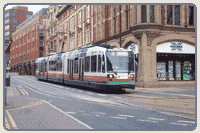


 






|

Taxonomy and description
 Terminology Terminology
Physical restrictions limit car use in urban areas or other specific zones
by reductions in road capacity such as street closures or reallocation
of road capacity from cars to other traffic such as buses, cyclists and
pedestrians. They include bus priorities,
cycle
lanes, extensive pedestrian areas,
street-running rail such as tram or light
rail systems and also traffic
calming measures. These cover all the measures to reduce or reallocate
of road capacity. Most individual measures are covered in detail in a
separate section. Restricted access to a defined area for certain types
of traffic such as through traffic are covered in regulatory
restrictions, which may not reduce road capacity overall but reduce
capacity for particular vehicle movement.
Styles of Physical Restrictions
Cairns et al (1998) collected over 60 case studies of reductions or reallocations
of road capacity and classified these cases into several types. Based
on their classification physical restrictions are distinguished into two
styles:
- Allocated to priority vehicles
Road capacity for car use is reallocated by introduction or extension
of bus priorities, cycle
lanes and light rail systems.
These measures generally aim not only to reduce car traffic volume but
also to encourage the use of public transport to provide a frequent,
punctual and reliable service.
- Converted to other use
Road capacity for car use is reduced by changes or extension of a defined
area (often a city centre) into a pedestrian area
or car-free area, the closure of a particular street entering a city
centre, and introduction of traffic cells in which a city centre is
divided into cells, where car traffic movement between each cell (or
entering from outer areas) is prohibited or restricted, based on limited
entrance points. Some types of vehicles like buses and service vehicles
are usually exempted from restrictions.
Temporary closure and reductions in capacity due to road or bridge repairs,
maintenance work and natural disasters were also collected by Cairns et
al (1998), because these cases provide relevant information about what
drivers actually do in response to changes in availability of road space.
However, these temporary measures do not target the reduction of car use,
so they are not included in this section.
Technology
There are few specific technological requirements for the operation of
physical restrictions, but urban traffic control
(UTC) systems help the efficient operation of road capacity reallocation
measures such as bus priorities and street-running rail. Public transport
priority is one of critical objectives for UTC systems, in which buses
or trams regularly travel through without stopping at junctions with traffic
signals by selective vehicle detection systems (Fitzroy and Smith, 1993).
When access for public transport or other types of vehicle is permitted
into a restricted area, the category of vehicles needs checking at the
entry points, using paper licenses. Current access control technologies,
which permits drivers to pass the point without stopping, are covered
in regulatory restrictions.

|




